
Honestly, encountering a bearded vulture can be both thrilling and a bit nerve-wracking. You might feel like you’re in the presence of a creature that has weathered the ages. Here’s the thing: knowing how to react can make a significant difference in your experience and in the welfare of the bird itself. Let’s dive deeper into this topic and explore what steps to take if you’re lucky enough to cross paths with this incredible raptor.
Understanding the Bearded Vulture
Before we jump into what to do when you see one, it’s helpful to know a bit about the bearded vulture itself. These birds are often mistaken for other vultures due to their size and shape, but they have a few distinct features that set them apart. Their feathers are mostly a beautiful mix of light colors and have a striking reddish-brown tint, which they get from coating themselves in mineral-rich mud.
Another fascinating aspect of their behavior is their diet. Unlike many vultures that primarily eat carrion, bearded vultures have a penchant for bones. Yes, bones! They are known for dropping bones from great heights onto rocks to break them, making it easier to access the nutritious marrow inside. This unique feeding method highlights their adaptability and intelligence, which makes encounters with them even more special.
Stay Calm and Observe
So, what happens if you spot a bearded vulture soaring gracefully above you? First and foremost, **stay calm**. It’s easy to get excited, but sudden movements can frighten the bird away. If you have binoculars or a camera, this is the perfect moment to observe its behavior.
You might notice how it glides effortlessly, using thermal currents to soar without much flapping. The wings spread wide, revealing the intricate feather patterns. Take a moment to appreciate this marvel of nature—it’s a unique opportunity! Remember to keep a respectful distance. Try to stay at least 100 meters away to minimize any stress on the bird and avoid disturbing its natural behavior.
Do Not Disturb Their Habitat
Bearded vultures are sensitive creatures that thrive in specific habitats. If you find one, it’s crucial to avoid disturbing their environment. This means staying on marked trails and not approaching their nesting areas. Even the smallest disturbance can have a significant impact on their safety and breeding success.
If you’re hiking with others, make sure to let them know to keep quiet and to give the bird space. Talking loudly or getting too close can disrupt their feeding or resting. Protecting their habitat helps ensure these wonderful birds can continue to thrive in the wild for generations to come.
Respect Their Space
As tempting as it may be to get a closer look, it’s essential to respect the **bearded vulture’s space**. Getting too close can lead to stress for the bird and potentially alter its future behavior. Instead of rushing in for a photo, enjoy the moment from a distance. If you’re keen on photography, set your camera to a zoom mode, which allows you to capture the beauty without intruding.
You might be wondering how to know if you’re too close. A simple rule is to watch for any signs of agitation. If the bird starts to flap its wings or move away from the area, you’re too close and should back off immediately. By doing this, you’re not just being considerate but also contributing to wildlife conservation efforts.
Reporting Your Sighting
After you’ve had your awe-inspiring moment with the bearded vulture, consider reporting your sighting to local wildlife authorities or conservation groups. **Sharing your encounter** can help experts track populations and understand their behavior better. Wildlife organizations often keep records of sightings to study patterns and conservation needs.
Include details like the date, location, and any notable behaviors you observed. This information can be invaluable for those working to protect these majestic creatures and their habitats. Plus, sharing your experience might inspire others to appreciate and respect wildlife even more.
Learning More About Bearded Vultures
If you’re fascinated by bearded vultures, why not learn more? Consider joining local birdwatching groups or conservation projects. Being part of these communities not only enhances your knowledge but also connects you with like-minded individuals who share your passion for wildlife.
Attend lectures, read articles, or even volunteer for field studies. The more you learn about these birds, the better equipped you’ll be to help protect them in the wild. Plus, it’s a rewarding way to spend your time and make a positive impact.
Final Thoughts
Encounters with a bearded vulture are rare and magical moments that can leave a lasting impression. Remember to stay calm, respect their space, and observe from a distance. Your awareness and actions can contribute significantly to the well-being of these magnificent birds.
So, next time you’re out in the wild, keep your eyes peeled. If you happen upon a bearded vulture, take a deep breath, appreciate the beauty of nature, and enjoy the moment—you’re witnessing a piece of the wild that many people never get to see. Happy birdwatching!

